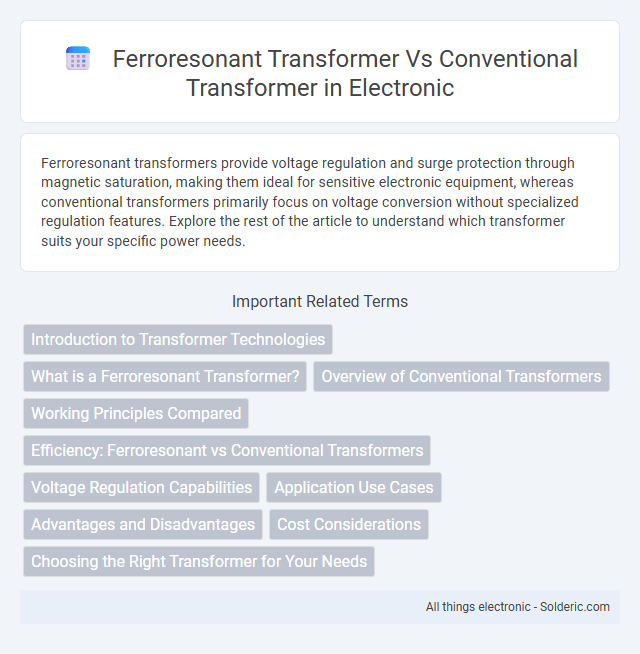Ferroresonant transformers provide voltage regulation and surge protection through magnetic saturation, making them ideal for sensitive electronic equipment, whereas conventional transformers primarily focus on voltage conversion without specialized regulation features. Explore the rest of the article to understand which transformer suits your specific power needs.
Comparison Table
| Feature | Ferroresonant Transformer | Conventional Transformer |
|---|---|---|
| Voltage Regulation | Excellent voltage stabilization under varying load | Voltage varies directly with load changes |
| Output Waveform | Maintains near-sinusoidal output waveform | Output waveform depends on input and load |
| Efficiency | Lower efficiency due to continuous core saturation | Higher efficiency at rated load |
| Size & Weight | Bulkier and heavier due to ferroresonant components | More compact and lighter |
| Cost | Higher initial cost | Lower initial cost |
| Noise | Produces audible hum from ferroresonant operation | Lower operational noise |
| Applications | Used in voltage regulation, power conditioning, sensitive equipment | Used in power distribution, general electrical isolation |
| Overload Handling | Better overload tolerance due to voltage stabilization | Limited overload tolerance |
Introduction to Transformer Technologies
Ferroresonant transformers utilize a nonlinear inductance and capacitor combination to regulate voltage and provide consistent output despite input voltage fluctuations, enhancing reliability in sensitive electronic devices. Conventional transformers primarily rely on electromagnetic induction with linear magnetic cores to transfer electrical energy between circuits, focusing on voltage conversion without distinct voltage regulation features. The ferroresonant technology's inherent voltage stabilization offers advantages in environments with unstable power supply compared to the standard design of conventional transformers.
What is a Ferroresonant Transformer?
A ferroresonant transformer is a specialized electrical device designed to regulate voltage by utilizing a nonlinear magnetic core and capacitor to maintain a constant output despite input voltage variations. Unlike conventional transformers, it provides superior voltage stabilization, noise filtering, and surge protection, making it ideal for sensitive electronic equipment. Your choice of a ferroresonant transformer ensures enhanced reliability and consistent power quality in fluctuating electrical environments.
Overview of Conventional Transformers
Conventional transformers operate on the principle of electromagnetic induction, efficiently transferring electrical energy between circuits through magnetic coupling. They consist of primary and secondary windings wound around a ferromagnetic core, designed to maintain voltage levels while minimizing energy loss. Your electrical system benefits from their reliability and simplicity, but they may generate voltage fluctuations under nonlinear loads, unlike ferroresonant transformers.
Working Principles Compared
Ferroresonant transformers operate on the principle of magnetic saturation and resonance, using a resonant circuit to regulate voltage and provide voltage stabilization under varying loads. Conventional transformers work based on electromagnetic induction, transferring electrical energy between circuits through mutual inductance without inherent voltage regulation capabilities. The ferroresonant transformer's design enables it to maintain a stable output voltage despite input fluctuations, whereas conventional transformers rely on external control systems for voltage regulation.
Efficiency: Ferroresonant vs Conventional Transformers
Ferroresonant transformers maintain nearly constant output voltage under varying loads, resulting in improved voltage regulation but generally exhibit lower efficiency due to continuous core saturation and associated losses. Conventional transformers typically achieve higher efficiency, often exceeding 95%, by minimizing core losses through design optimized for linear operation under normal load conditions. Efficiency in ferroresonant transformers can be as low as 75-85%, while conventional transformers usually operate between 95-99%, making conventional units preferable for energy-sensitive applications.
Voltage Regulation Capabilities
Ferroresonant transformers provide superior voltage regulation capabilities by maintaining a nearly constant output voltage despite input voltage fluctuations, making them ideal for sensitive electronic equipment. Conventional transformers exhibit variable output voltage proportional to changes in input voltage and load conditions, resulting in less stable voltage regulation. The ferroresonant design inherently absorbs voltage spikes and surges, offering improved protection and consistent power quality compared to conventional transformers.
Application Use Cases
Ferroresonant transformers excel in applications requiring voltage regulation and surge protection, such as industrial control systems, medical equipment, and communication devices, where maintaining a stable output despite input fluctuations is critical. Conventional transformers are widely used in general power distribution, stepping voltage levels up or down for residential, commercial, and industrial electrical systems with predictable load conditions. Ferroresonant transformers are preferred in environments with high electrical noise or variable input voltage, whereas conventional transformers are suitable for consistent, high-efficiency power transfer in standard grid applications.
Advantages and Disadvantages
Ferroresonant transformers offer superior voltage regulation and noise filtering compared to conventional transformers, making them ideal for sensitive electronic equipment requiring stable power. However, they are generally larger, heavier, and less energy-efficient, leading to higher operational costs and less suitability for general-purpose applications. Your choice between the two depends on whether voltage stability or energy efficiency is the primary concern in your specific use case.
Cost Considerations
Ferroresonant transformers typically have higher initial costs compared to conventional transformers due to their specialized design and additional components for voltage regulation. However, their ability to provide stable output voltage and protection against power surges can reduce maintenance expenses and downtime, potentially lowering total ownership costs. Evaluating your specific application requirements and energy efficiency needs will help determine which transformer offers the best cost balance.
Choosing the Right Transformer for Your Needs
Ferroresonant transformers provide superior voltage regulation and noise suppression, making them ideal for sensitive electronic equipment requiring stable power. Conventional transformers excel in cost-efficiency and high-load capacity applications where precise voltage control is less critical. Assess your power stability needs and budget constraints to select the transformer that best matches your operational demands.
ferroresonant transformer vs conventional transformer Infographic

 solderic.com
solderic.com